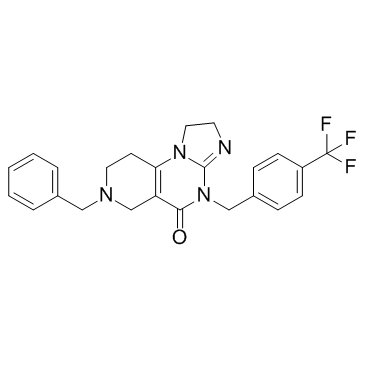| Description |
ONC212, a fluorinated-ONC201 analogue, is a promising anti-cancer drug and also a selective agonist of GPR132.
|
| Related Catalog |
|
| Target |
GPR132[1]
|
| In Vitro |
Cell proliferation assay reveals that at least a ten-fold lower concentration of ONC212 is needed to achieve 50% growth inhibition in comparison to ONC201. ONC212 shows GI50 values in the range of 0.1 to 0.4 μM, while the corresponding ONC201 GI50 values are in the range of 4 to 9 μM for the seven pancreatic cancer cell lines tested. Long-term cell proliferation assay shows that both ONC201 and ONC212 are comparable in inhibiting colony formation at a 20 µM dose. However, at a 5 µM dose, ONC212 is about 50-times more potent than ONC201 in preventing colony formation in four out of the seven pancreatic cancer cell lines tested. Induction of apoptosis by ONC212 is an earlier event than ONC201. Treatment with ONC201 and ONC212 reduces the expression of anti-apoptotic markers such as XIAP and MCL-1. Western blot analysis shows that in the HPAF-II cell line, ATF4 and phosphorylated EIF2α are upregulated as early as 6 to 12 hours post ONC201 or ONC212 treatment[2].
|
| In Vivo |
Biweekly oral administration of 50 mg/kg ONC212 markedly inhibits Acute myeloid leukemia (AML) expansion and prolongs overall survival (p=0.0003). Median survival increases from 43 d in controls to 49 d in the ONC212-treated group (+14%)[1]. ONC212 treatment exhibits significantly greater growth inhibition in comparison to ONC201. A dose of 50 mg/kg of ONC212 administered three-times a week is sufficient to lead to significant growth inhibition of tumors compare to the control group for these two models. Results demonstrate that ONC212 treated tumors show reduced proliferation in the HPAF-II model[2]. In vivo toxicity assessment experiments show that ONC212 is well tolerated up to 250 mg/kg. 300 mg/kg of ONC212 causes splenic damage and elevates liver enzymes. ONC212 has a slightly shorter half-life than ONC201, with a clearance from the blood at 12 hours, T1/2 of 4.3 hours, and Cmax of 1.4 µg/mL[3].
|
| Cell Assay |
All pancreatic cancer cell lines are treated with ONC201 or ONC212 at the indicated doses and time-points. Post-treatment, both floating and adherent cells are collected, fixed in 70% ethanol and stained with propidium iodide in the presence of ribonuclease A. Flow cytometric data is collected using a flow cytometer. The sub-G1 fraction (apoptotic) is quantified, and analysis is performed to quantify the distribution of cells in G1, S and G2-M phases of the cell cycle utilizing[2].
|
| Animal Admin |
Six- to seven-week-old female athymic nu/nu mice are used in this study. A total of 3 to 5×106 luciferase-expressing cells are suspended in 50 μL of PBS mixed with 50 μL of Matrigel and subcutaneously injected into the rear flanks of the mice. When tumor volume reaches an average of 100 to 150 cm3, mice are randomly assigned to the indicated control or treatment groups. ONC201 and ONC212 are delivered in a solution of 10% DMSO, 20% Kolliphor®EL and 70% PBS by oral gavage. The length (L) and width (W) of the tumors are measured 1 to 2 times a week using a digital caliper, and the volume of the tumor is calculated. Mice are also weighed once a week to monitor signs of drug toxicity[2].
|
| References |
[1]. Takenobu Nii, et al. The Novel Imipridone ONC212 Induces Pronounced Anti-Leukemia Effects in Vitro and In Vivo and Is Highly Synergistic with the BCL-2 Inhibitor ABT-199. ASH. 2017. [2]. Lev A, et al. Anti-pancreatic cancer activity of ONC212 involves the unfolded protein response (UPR) and is reduced by IGF1-R and GRP78/BIP. Oncotarget. 2017 Sep 12;8(47):81776-81793. [3]. Wagner J, et al. Preclinical evaluation of the imipridone family, analogs of clinical stage anti-cancer small molecule ONC201, reveals potent anti-cancer effects of ONC212. Cell Cycle. 2017 Oct 2;16(19):1790-1799.
|
